A Sociological Study of the Construction of Childhood
VerifiedAdded on 2021/04/19
|11
|2269
|85
Essay
AI Summary
This essay undertakes a sociological examination of the construction of childhood, analyzing five distinct perspectives: the innocent child, the out-of-control child, the child as commodity, the agentic child, and the child as victim. The study explores how these constructions are shaped by societal values, historical contexts, and cultural norms. The essay delves into the limitations and implications of each construct, highlighting how they influence policies, initiatives, and societal attitudes toward children. The analysis compares and contrasts these perspectives, emphasizing the significance of the agentic child model, which promotes children's agency and potential for self-realization through collaboration. The essay concludes by advocating for an approach that acknowledges the diverse experiences and voices of children, fostering their participation in decision-making processes and educational settings.
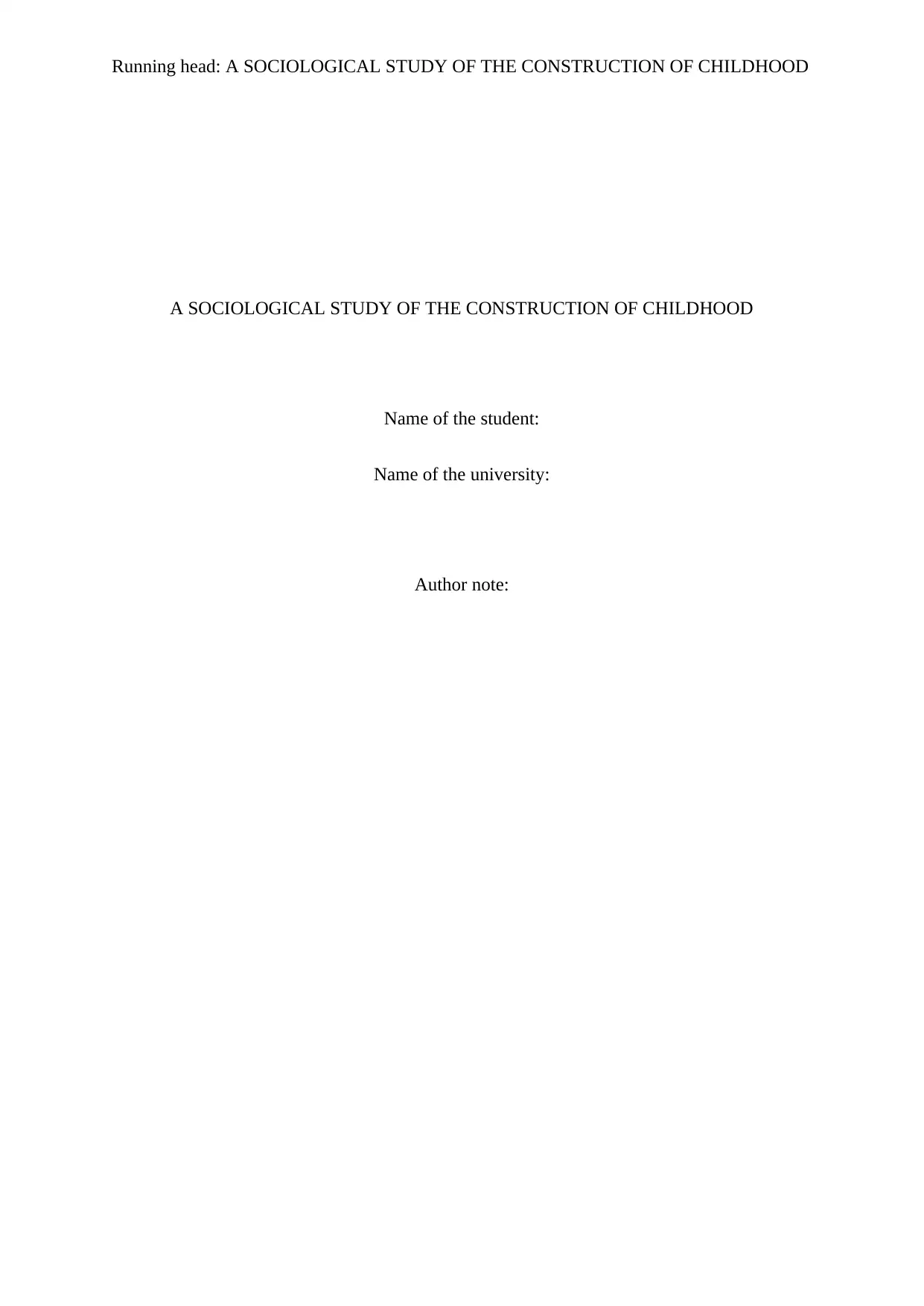
Running head: A SOCIOLOGICAL STUDY OF THE CONSTRUCTION OF CHILDHOOD
A SOCIOLOGICAL STUDY OF THE CONSTRUCTION OF CHILDHOOD
Name of the student:
Name of the university:
Author note:
A SOCIOLOGICAL STUDY OF THE CONSTRUCTION OF CHILDHOOD
Name of the student:
Name of the university:
Author note:
Paraphrase This Document
Need a fresh take? Get an instant paraphrase of this document with our AI Paraphraser
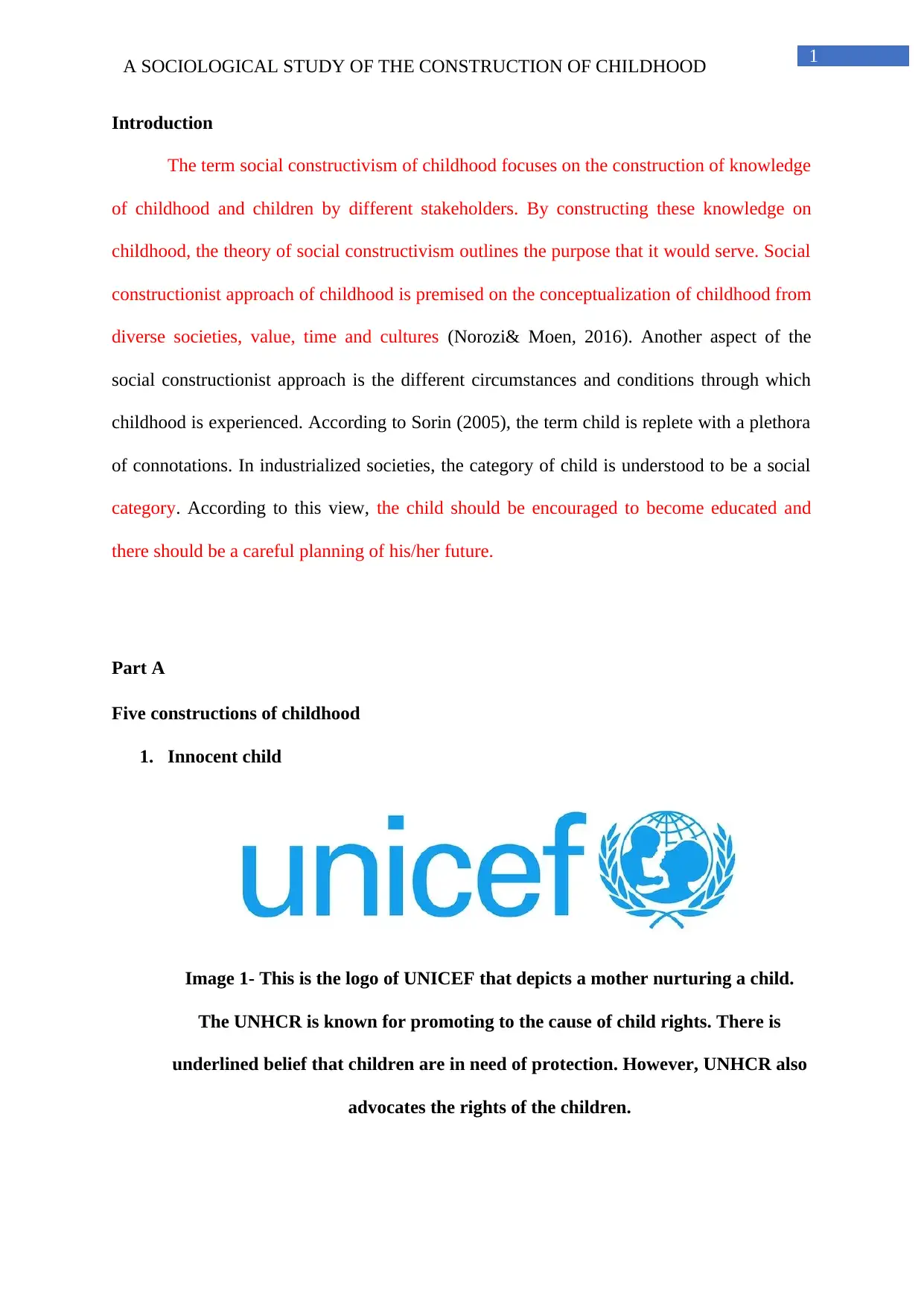
1
A SOCIOLOGICAL STUDY OF THE CONSTRUCTION OF CHILDHOOD
Introduction
The term social constructivism of childhood focuses on the construction of knowledge
of childhood and children by different stakeholders. By constructing these knowledge on
childhood, the theory of social constructivism outlines the purpose that it would serve. Social
constructionist approach of childhood is premised on the conceptualization of childhood from
diverse societies, value, time and cultures (Norozi& Moen, 2016). Another aspect of the
social constructionist approach is the different circumstances and conditions through which
childhood is experienced. According to Sorin (2005), the term child is replete with a plethora
of connotations. In industrialized societies, the category of child is understood to be a social
category. According to this view, the child should be encouraged to become educated and
there should be a careful planning of his/her future.
Part A
Five constructions of childhood
1. Innocent child
Image 1- This is the logo of UNICEF that depicts a mother nurturing a child.
The UNHCR is known for promoting to the cause of child rights. There is
underlined belief that children are in need of protection. However, UNHCR also
advocates the rights of the children.
A SOCIOLOGICAL STUDY OF THE CONSTRUCTION OF CHILDHOOD
Introduction
The term social constructivism of childhood focuses on the construction of knowledge
of childhood and children by different stakeholders. By constructing these knowledge on
childhood, the theory of social constructivism outlines the purpose that it would serve. Social
constructionist approach of childhood is premised on the conceptualization of childhood from
diverse societies, value, time and cultures (Norozi& Moen, 2016). Another aspect of the
social constructionist approach is the different circumstances and conditions through which
childhood is experienced. According to Sorin (2005), the term child is replete with a plethora
of connotations. In industrialized societies, the category of child is understood to be a social
category. According to this view, the child should be encouraged to become educated and
there should be a careful planning of his/her future.
Part A
Five constructions of childhood
1. Innocent child
Image 1- This is the logo of UNICEF that depicts a mother nurturing a child.
The UNHCR is known for promoting to the cause of child rights. There is
underlined belief that children are in need of protection. However, UNHCR also
advocates the rights of the children.
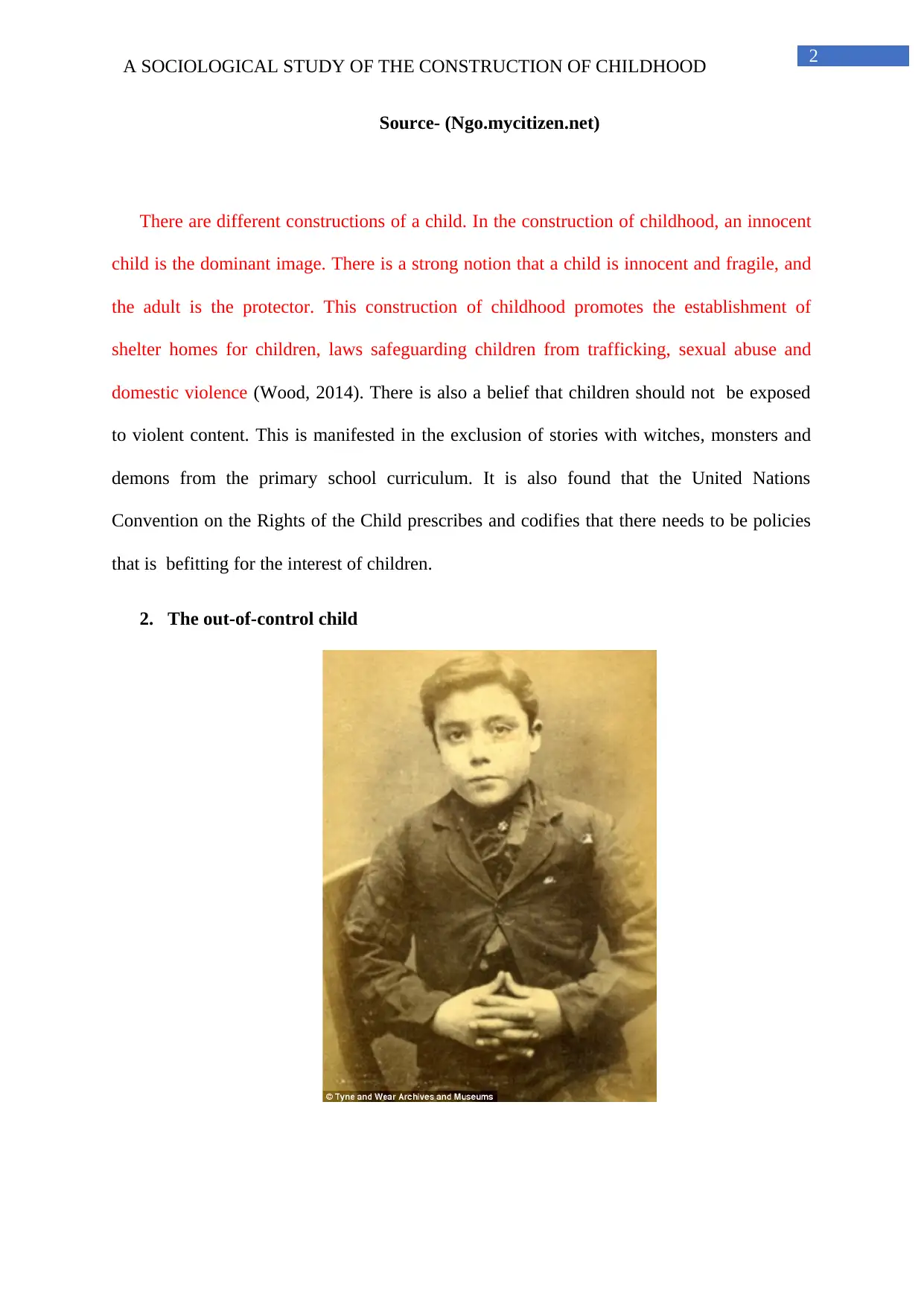
2
A SOCIOLOGICAL STUDY OF THE CONSTRUCTION OF CHILDHOOD
Source- (Ngo.mycitizen.net)
There are different constructions of a child. In the construction of childhood, an innocent
child is the dominant image. There is a strong notion that a child is innocent and fragile, and
the adult is the protector. This construction of childhood promotes the establishment of
shelter homes for children, laws safeguarding children from trafficking, sexual abuse and
domestic violence (Wood, 2014). There is also a belief that children should not be exposed
to violent content. This is manifested in the exclusion of stories with witches, monsters and
demons from the primary school curriculum. It is also found that the United Nations
Convention on the Rights of the Child prescribes and codifies that there needs to be policies
that is befitting for the interest of children.
2. The out-of-control child
A SOCIOLOGICAL STUDY OF THE CONSTRUCTION OF CHILDHOOD
Source- (Ngo.mycitizen.net)
There are different constructions of a child. In the construction of childhood, an innocent
child is the dominant image. There is a strong notion that a child is innocent and fragile, and
the adult is the protector. This construction of childhood promotes the establishment of
shelter homes for children, laws safeguarding children from trafficking, sexual abuse and
domestic violence (Wood, 2014). There is also a belief that children should not be exposed
to violent content. This is manifested in the exclusion of stories with witches, monsters and
demons from the primary school curriculum. It is also found that the United Nations
Convention on the Rights of the Child prescribes and codifies that there needs to be policies
that is befitting for the interest of children.
2. The out-of-control child
⊘ This is a preview!⊘
Do you want full access?
Subscribe today to unlock all pages.

Trusted by 1+ million students worldwide
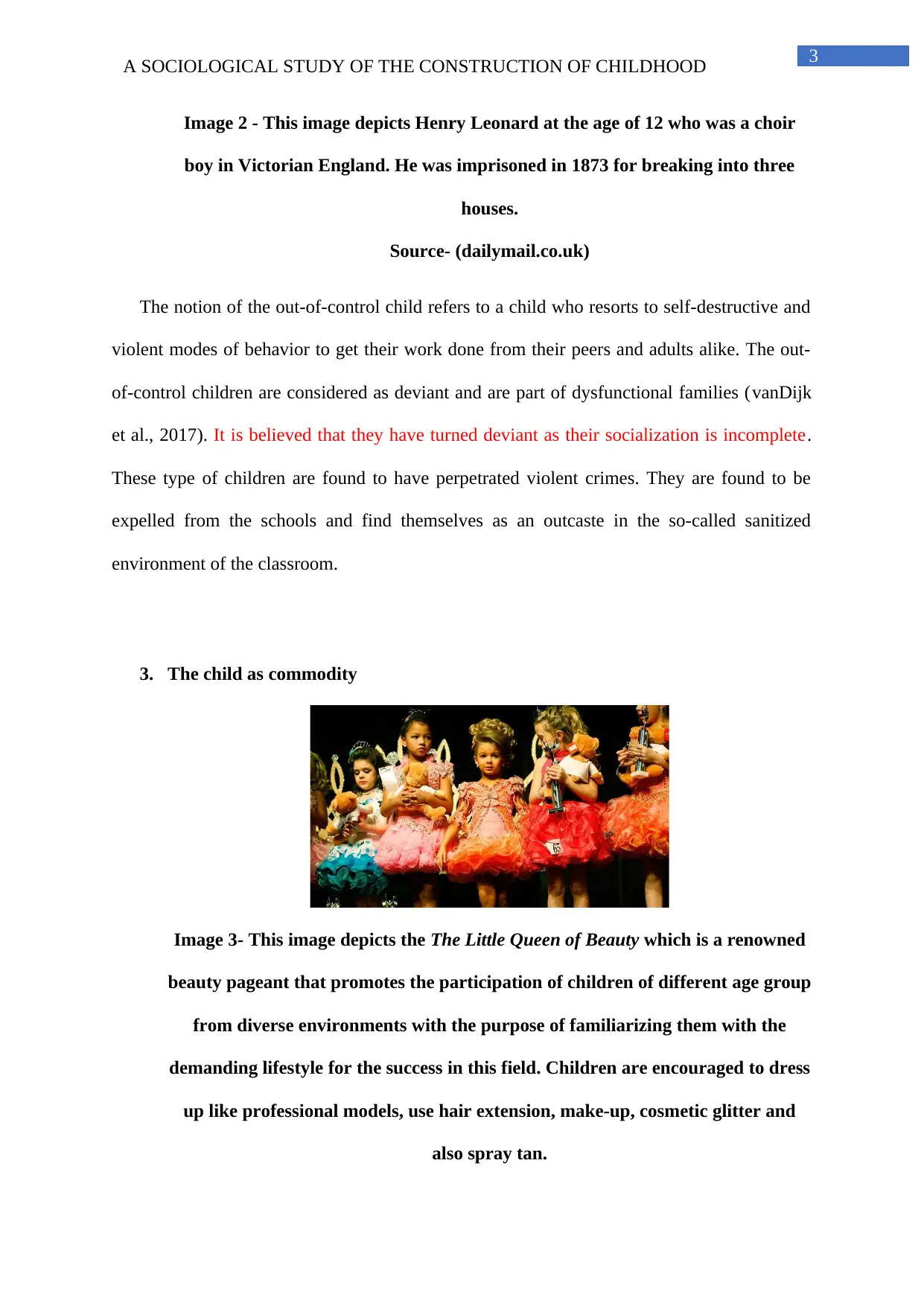
3
A SOCIOLOGICAL STUDY OF THE CONSTRUCTION OF CHILDHOOD
Image 2 - This image depicts Henry Leonard at the age of 12 who was a choir
boy in Victorian England. He was imprisoned in 1873 for breaking into three
houses.
Source- (dailymail.co.uk)
The notion of the out-of-control child refers to a child who resorts to self-destructive and
violent modes of behavior to get their work done from their peers and adults alike. The out-
of-control children are considered as deviant and are part of dysfunctional families (vanDijk
et al., 2017). It is believed that they have turned deviant as their socialization is incomplete.
These type of children are found to have perpetrated violent crimes. They are found to be
expelled from the schools and find themselves as an outcaste in the so-called sanitized
environment of the classroom.
3. The child as commodity
Image 3- This image depicts the The Little Queen of Beauty which is a renowned
beauty pageant that promotes the participation of children of different age group
from diverse environments with the purpose of familiarizing them with the
demanding lifestyle for the success in this field. Children are encouraged to dress
up like professional models, use hair extension, make-up, cosmetic glitter and
also spray tan.
A SOCIOLOGICAL STUDY OF THE CONSTRUCTION OF CHILDHOOD
Image 2 - This image depicts Henry Leonard at the age of 12 who was a choir
boy in Victorian England. He was imprisoned in 1873 for breaking into three
houses.
Source- (dailymail.co.uk)
The notion of the out-of-control child refers to a child who resorts to self-destructive and
violent modes of behavior to get their work done from their peers and adults alike. The out-
of-control children are considered as deviant and are part of dysfunctional families (vanDijk
et al., 2017). It is believed that they have turned deviant as their socialization is incomplete.
These type of children are found to have perpetrated violent crimes. They are found to be
expelled from the schools and find themselves as an outcaste in the so-called sanitized
environment of the classroom.
3. The child as commodity
Image 3- This image depicts the The Little Queen of Beauty which is a renowned
beauty pageant that promotes the participation of children of different age group
from diverse environments with the purpose of familiarizing them with the
demanding lifestyle for the success in this field. Children are encouraged to dress
up like professional models, use hair extension, make-up, cosmetic glitter and
also spray tan.
Paraphrase This Document
Need a fresh take? Get an instant paraphrase of this document with our AI Paraphraser
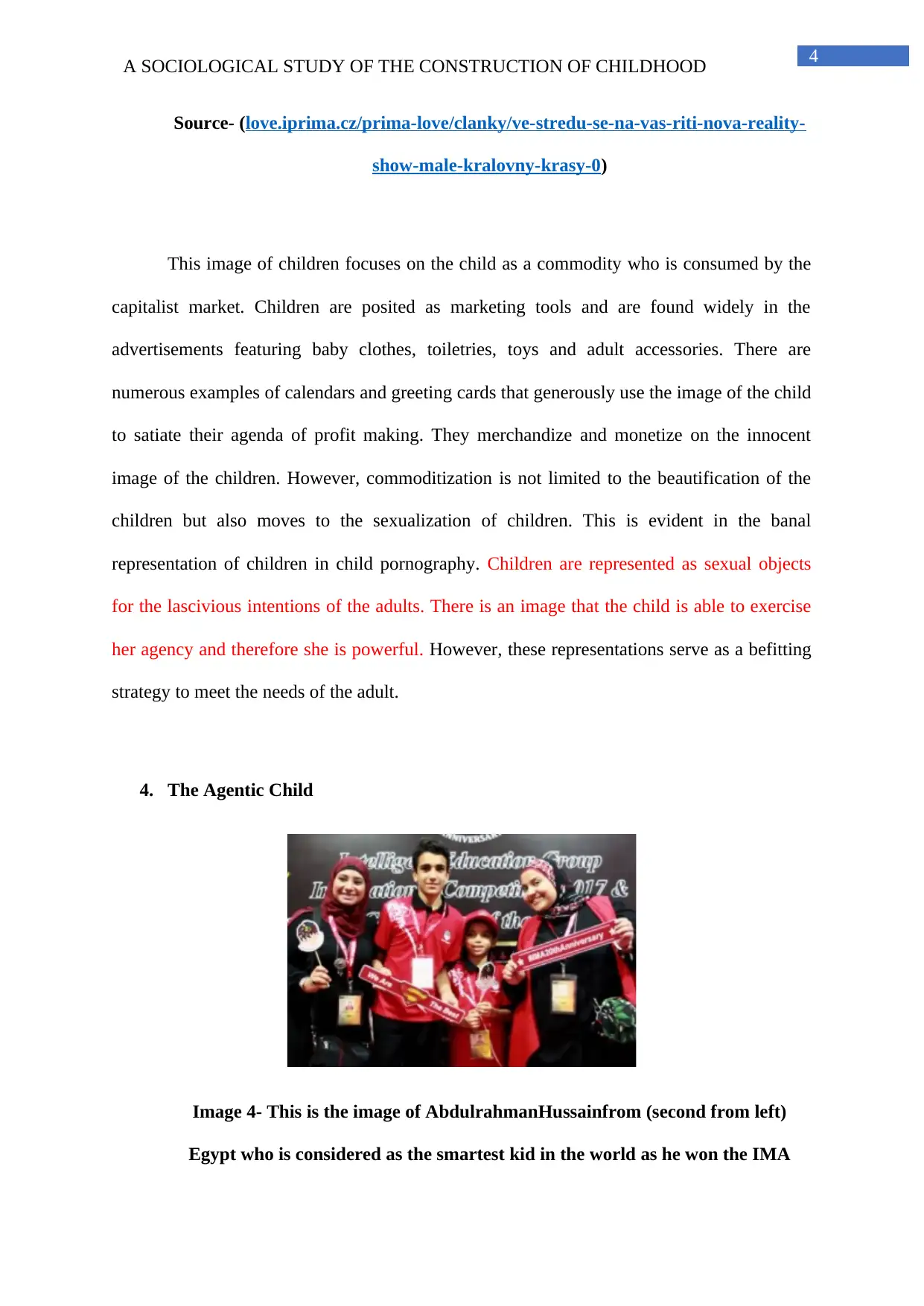
4
A SOCIOLOGICAL STUDY OF THE CONSTRUCTION OF CHILDHOOD
Source- (love.iprima.cz/prima-love/clanky/ve-stredu-se-na-vas-riti-nova-reality-
show-male-kralovny-krasy-0)
This image of children focuses on the child as a commodity who is consumed by the
capitalist market. Children are posited as marketing tools and are found widely in the
advertisements featuring baby clothes, toiletries, toys and adult accessories. There are
numerous examples of calendars and greeting cards that generously use the image of the child
to satiate their agenda of profit making. They merchandize and monetize on the innocent
image of the children. However, commoditization is not limited to the beautification of the
children but also moves to the sexualization of children. This is evident in the banal
representation of children in child pornography. Children are represented as sexual objects
for the lascivious intentions of the adults. There is an image that the child is able to exercise
her agency and therefore she is powerful. However, these representations serve as a befitting
strategy to meet the needs of the adult.
4. The Agentic Child
Image 4- This is the image of AbdulrahmanHussainfrom (second from left)
Egypt who is considered as the smartest kid in the world as he won the IMA
A SOCIOLOGICAL STUDY OF THE CONSTRUCTION OF CHILDHOOD
Source- (love.iprima.cz/prima-love/clanky/ve-stredu-se-na-vas-riti-nova-reality-
show-male-kralovny-krasy-0)
This image of children focuses on the child as a commodity who is consumed by the
capitalist market. Children are posited as marketing tools and are found widely in the
advertisements featuring baby clothes, toiletries, toys and adult accessories. There are
numerous examples of calendars and greeting cards that generously use the image of the child
to satiate their agenda of profit making. They merchandize and monetize on the innocent
image of the children. However, commoditization is not limited to the beautification of the
children but also moves to the sexualization of children. This is evident in the banal
representation of children in child pornography. Children are represented as sexual objects
for the lascivious intentions of the adults. There is an image that the child is able to exercise
her agency and therefore she is powerful. However, these representations serve as a befitting
strategy to meet the needs of the adult.
4. The Agentic Child
Image 4- This is the image of AbdulrahmanHussainfrom (second from left)
Egypt who is considered as the smartest kid in the world as he won the IMA
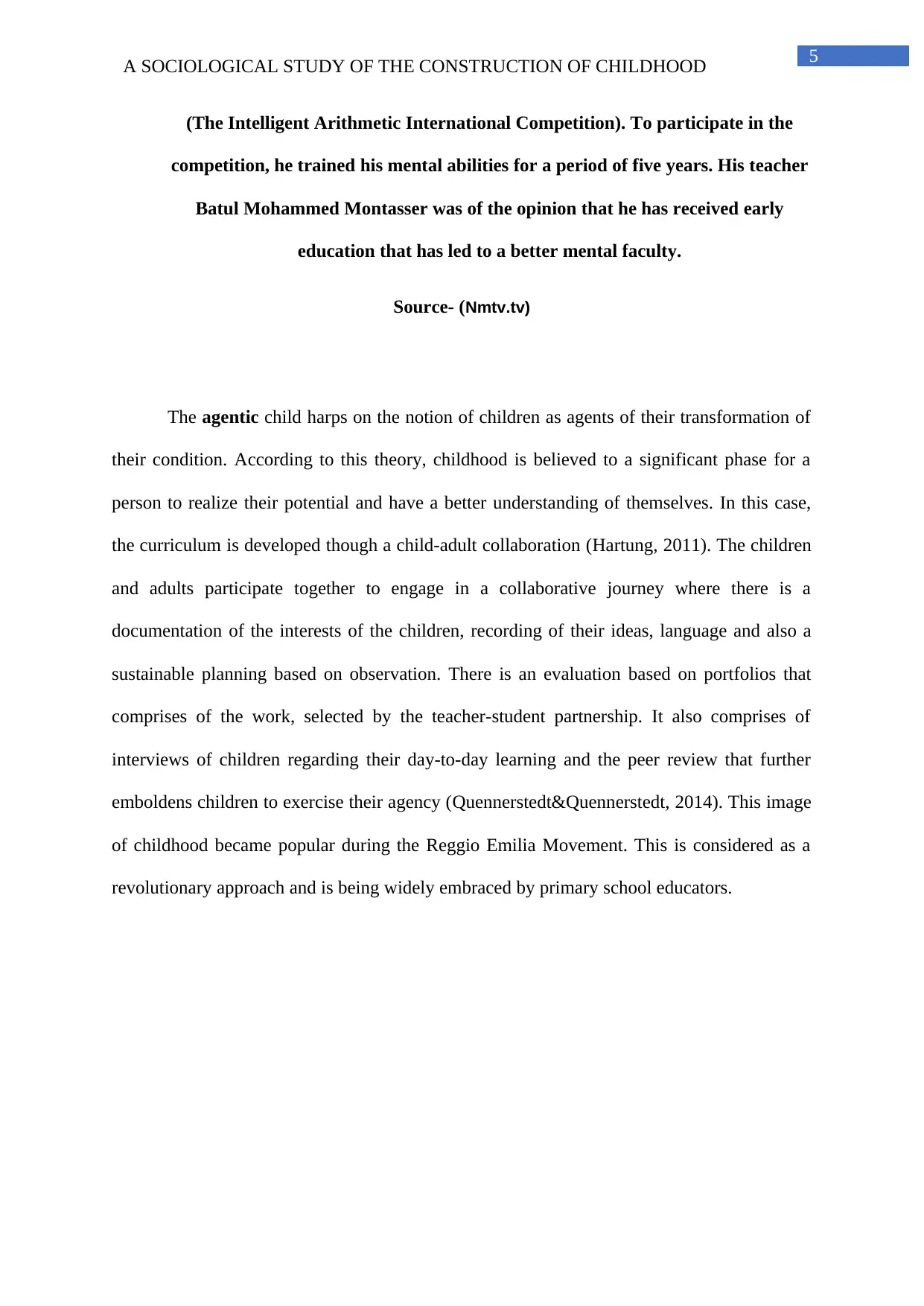
5
A SOCIOLOGICAL STUDY OF THE CONSTRUCTION OF CHILDHOOD
(The Intelligent Arithmetic International Competition). To participate in the
competition, he trained his mental abilities for a period of five years. His teacher
Batul Mohammed Montasser was of the opinion that he has received early
education that has led to a better mental faculty.
Source- (Nmtv.tv)
The agentic child harps on the notion of children as agents of their transformation of
their condition. According to this theory, childhood is believed to a significant phase for a
person to realize their potential and have a better understanding of themselves. In this case,
the curriculum is developed though a child-adult collaboration (Hartung, 2011). The children
and adults participate together to engage in a collaborative journey where there is a
documentation of the interests of the children, recording of their ideas, language and also a
sustainable planning based on observation. There is an evaluation based on portfolios that
comprises of the work, selected by the teacher-student partnership. It also comprises of
interviews of children regarding their day-to-day learning and the peer review that further
emboldens children to exercise their agency (Quennerstedt&Quennerstedt, 2014). This image
of childhood became popular during the Reggio Emilia Movement. This is considered as a
revolutionary approach and is being widely embraced by primary school educators.
A SOCIOLOGICAL STUDY OF THE CONSTRUCTION OF CHILDHOOD
(The Intelligent Arithmetic International Competition). To participate in the
competition, he trained his mental abilities for a period of five years. His teacher
Batul Mohammed Montasser was of the opinion that he has received early
education that has led to a better mental faculty.
Source- (Nmtv.tv)
The agentic child harps on the notion of children as agents of their transformation of
their condition. According to this theory, childhood is believed to a significant phase for a
person to realize their potential and have a better understanding of themselves. In this case,
the curriculum is developed though a child-adult collaboration (Hartung, 2011). The children
and adults participate together to engage in a collaborative journey where there is a
documentation of the interests of the children, recording of their ideas, language and also a
sustainable planning based on observation. There is an evaluation based on portfolios that
comprises of the work, selected by the teacher-student partnership. It also comprises of
interviews of children regarding their day-to-day learning and the peer review that further
emboldens children to exercise their agency (Quennerstedt&Quennerstedt, 2014). This image
of childhood became popular during the Reggio Emilia Movement. This is considered as a
revolutionary approach and is being widely embraced by primary school educators.
⊘ This is a preview!⊘
Do you want full access?
Subscribe today to unlock all pages.

Trusted by 1+ million students worldwide
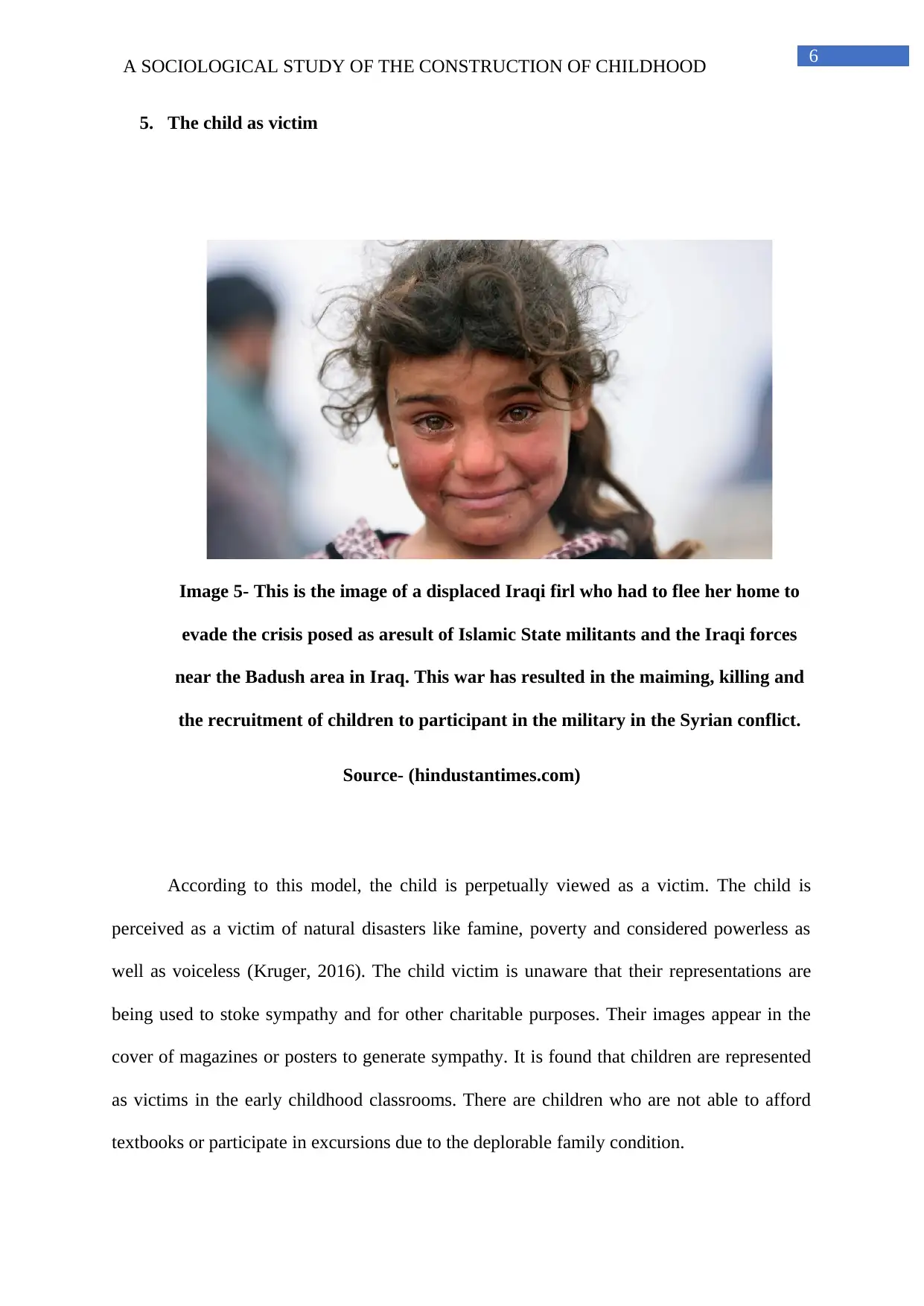
6
A SOCIOLOGICAL STUDY OF THE CONSTRUCTION OF CHILDHOOD
5. The child as victim
Image 5- This is the image of a displaced Iraqi firl who had to flee her home to
evade the crisis posed as aresult of Islamic State militants and the Iraqi forces
near the Badush area in Iraq. This war has resulted in the maiming, killing and
the recruitment of children to participant in the military in the Syrian conflict.
Source- (hindustantimes.com)
According to this model, the child is perpetually viewed as a victim. The child is
perceived as a victim of natural disasters like famine, poverty and considered powerless as
well as voiceless (Kruger, 2016). The child victim is unaware that their representations are
being used to stoke sympathy and for other charitable purposes. Their images appear in the
cover of magazines or posters to generate sympathy. It is found that children are represented
as victims in the early childhood classrooms. There are children who are not able to afford
textbooks or participate in excursions due to the deplorable family condition.
A SOCIOLOGICAL STUDY OF THE CONSTRUCTION OF CHILDHOOD
5. The child as victim
Image 5- This is the image of a displaced Iraqi firl who had to flee her home to
evade the crisis posed as aresult of Islamic State militants and the Iraqi forces
near the Badush area in Iraq. This war has resulted in the maiming, killing and
the recruitment of children to participant in the military in the Syrian conflict.
Source- (hindustantimes.com)
According to this model, the child is perpetually viewed as a victim. The child is
perceived as a victim of natural disasters like famine, poverty and considered powerless as
well as voiceless (Kruger, 2016). The child victim is unaware that their representations are
being used to stoke sympathy and for other charitable purposes. Their images appear in the
cover of magazines or posters to generate sympathy. It is found that children are represented
as victims in the early childhood classrooms. There are children who are not able to afford
textbooks or participate in excursions due to the deplorable family condition.
Paraphrase This Document
Need a fresh take? Get an instant paraphrase of this document with our AI Paraphraser
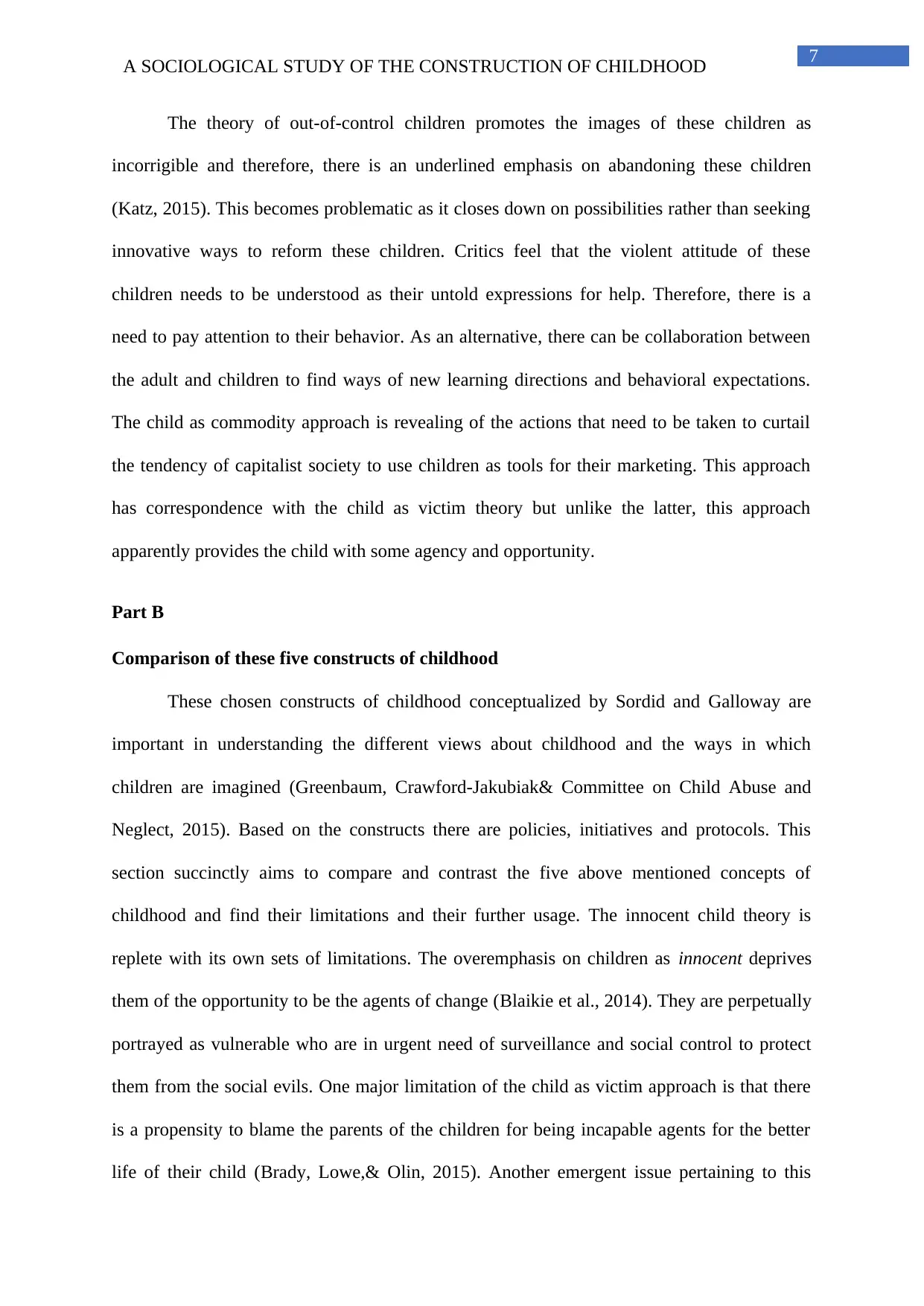
7
A SOCIOLOGICAL STUDY OF THE CONSTRUCTION OF CHILDHOOD
The theory of out-of-control children promotes the images of these children as
incorrigible and therefore, there is an underlined emphasis on abandoning these children
(Katz, 2015). This becomes problematic as it closes down on possibilities rather than seeking
innovative ways to reform these children. Critics feel that the violent attitude of these
children needs to be understood as their untold expressions for help. Therefore, there is a
need to pay attention to their behavior. As an alternative, there can be collaboration between
the adult and children to find ways of new learning directions and behavioral expectations.
The child as commodity approach is revealing of the actions that need to be taken to curtail
the tendency of capitalist society to use children as tools for their marketing. This approach
has correspondence with the child as victim theory but unlike the latter, this approach
apparently provides the child with some agency and opportunity.
Part B
Comparison of these five constructs of childhood
These chosen constructs of childhood conceptualized by Sordid and Galloway are
important in understanding the different views about childhood and the ways in which
children are imagined (Greenbaum, Crawford-Jakubiak& Committee on Child Abuse and
Neglect, 2015). Based on the constructs there are policies, initiatives and protocols. This
section succinctly aims to compare and contrast the five above mentioned concepts of
childhood and find their limitations and their further usage. The innocent child theory is
replete with its own sets of limitations. The overemphasis on children as innocent deprives
them of the opportunity to be the agents of change (Blaikie et al., 2014). They are perpetually
portrayed as vulnerable who are in urgent need of surveillance and social control to protect
them from the social evils. One major limitation of the child as victim approach is that there
is a propensity to blame the parents of the children for being incapable agents for the better
life of their child (Brady, Lowe,& Olin, 2015). Another emergent issue pertaining to this
A SOCIOLOGICAL STUDY OF THE CONSTRUCTION OF CHILDHOOD
The theory of out-of-control children promotes the images of these children as
incorrigible and therefore, there is an underlined emphasis on abandoning these children
(Katz, 2015). This becomes problematic as it closes down on possibilities rather than seeking
innovative ways to reform these children. Critics feel that the violent attitude of these
children needs to be understood as their untold expressions for help. Therefore, there is a
need to pay attention to their behavior. As an alternative, there can be collaboration between
the adult and children to find ways of new learning directions and behavioral expectations.
The child as commodity approach is revealing of the actions that need to be taken to curtail
the tendency of capitalist society to use children as tools for their marketing. This approach
has correspondence with the child as victim theory but unlike the latter, this approach
apparently provides the child with some agency and opportunity.
Part B
Comparison of these five constructs of childhood
These chosen constructs of childhood conceptualized by Sordid and Galloway are
important in understanding the different views about childhood and the ways in which
children are imagined (Greenbaum, Crawford-Jakubiak& Committee on Child Abuse and
Neglect, 2015). Based on the constructs there are policies, initiatives and protocols. This
section succinctly aims to compare and contrast the five above mentioned concepts of
childhood and find their limitations and their further usage. The innocent child theory is
replete with its own sets of limitations. The overemphasis on children as innocent deprives
them of the opportunity to be the agents of change (Blaikie et al., 2014). They are perpetually
portrayed as vulnerable who are in urgent need of surveillance and social control to protect
them from the social evils. One major limitation of the child as victim approach is that there
is a propensity to blame the parents of the children for being incapable agents for the better
life of their child (Brady, Lowe,& Olin, 2015). Another emergent issue pertaining to this

8
A SOCIOLOGICAL STUDY OF THE CONSTRUCTION OF CHILDHOOD
approach is that there needs to be an invigorating outlook from the educators to understand
the lifeworld of these children and seek strategies that would enable the child to have agency.
Much like the innocent child theory, this theory reduces the child as having no agency and
therefore evokes sympathy for the children. Out of all the approaches, the agentic child
theory is proved to more sophisticated and appropriate to respond to the events in one’s
childhood. Carrying forward the legacy of this theory, scholars have exhorted to include
diversity and the multiple values shared by children to render their voices as independent.
There has also been suggestion for positioning children as equal partners in their educational
decision-making.
Conclusion
The above discussion on the five selected constructs of childhood facilitated an
understanding of the different constructions and representations of children in media along
with different social institutions. It was found that in the present context the agentic child
model is most appropriate as it brings out the true potential in children and encourages them
to discover their talents through a collaboration with the adult.
A SOCIOLOGICAL STUDY OF THE CONSTRUCTION OF CHILDHOOD
approach is that there needs to be an invigorating outlook from the educators to understand
the lifeworld of these children and seek strategies that would enable the child to have agency.
Much like the innocent child theory, this theory reduces the child as having no agency and
therefore evokes sympathy for the children. Out of all the approaches, the agentic child
theory is proved to more sophisticated and appropriate to respond to the events in one’s
childhood. Carrying forward the legacy of this theory, scholars have exhorted to include
diversity and the multiple values shared by children to render their voices as independent.
There has also been suggestion for positioning children as equal partners in their educational
decision-making.
Conclusion
The above discussion on the five selected constructs of childhood facilitated an
understanding of the different constructions and representations of children in media along
with different social institutions. It was found that in the present context the agentic child
model is most appropriate as it brings out the true potential in children and encourages them
to discover their talents through a collaboration with the adult.
⊘ This is a preview!⊘
Do you want full access?
Subscribe today to unlock all pages.

Trusted by 1+ million students worldwide

9
A SOCIOLOGICAL STUDY OF THE CONSTRUCTION OF CHILDHOOD
Reference
Blaikie, P., Cannon, T., Davis, I., & Wisner, B. (2014). At risk: natural hazards, people's
vulnerability and disasters. Routledge.
Brady, G., Lowe, P., & Olin Lauritzen, S. (2015). Connecting a sociology of childhood
perspective with the study of child health, illness and wellbeing:
introduction. Sociology of health & illness, 37(2), 173-183.
Greenbaum, J., Crawford-Jakubiak, J. E., & Committee on Child Abuse and Neglect. (2015).
Child sex trafficking and commercial sexual exploitation: health care needs of
victims. Pediatrics, 135(3), 566-574
Hartung, C. (2011). Governing the'agentic'child citizen: A poststructural analysis of
children's participation.
hern, E. C., Hershkowitz, I., Lamb, M. E., Blasbalg, U., &Winstanley, A. (2014). Support
and reluctance in the pre‐substantive phase of alleged child abuse victim investigative
interviews: Revised versus Standard NICHD protocols. Behavioral sciences & the
law, 32(6), 762-774.
Katz, E. (2015). Domestic violence, children's agency and mother–child relationships:
Towards a more advanced model. Children & Society, 29(1), 69-79.
Kruger, P. A. (2016). Mothers and their children as victims in war: Amos 1: 13 against the
background of the ancient Near East. Old Testament Essays, 29(1), 100-115.
Norozi, S. A., & Moen, T. (2016). Childhood as a social construction. Journal of Educational
and Social Research, 6(2), 75.
A SOCIOLOGICAL STUDY OF THE CONSTRUCTION OF CHILDHOOD
Reference
Blaikie, P., Cannon, T., Davis, I., & Wisner, B. (2014). At risk: natural hazards, people's
vulnerability and disasters. Routledge.
Brady, G., Lowe, P., & Olin Lauritzen, S. (2015). Connecting a sociology of childhood
perspective with the study of child health, illness and wellbeing:
introduction. Sociology of health & illness, 37(2), 173-183.
Greenbaum, J., Crawford-Jakubiak, J. E., & Committee on Child Abuse and Neglect. (2015).
Child sex trafficking and commercial sexual exploitation: health care needs of
victims. Pediatrics, 135(3), 566-574
Hartung, C. (2011). Governing the'agentic'child citizen: A poststructural analysis of
children's participation.
hern, E. C., Hershkowitz, I., Lamb, M. E., Blasbalg, U., &Winstanley, A. (2014). Support
and reluctance in the pre‐substantive phase of alleged child abuse victim investigative
interviews: Revised versus Standard NICHD protocols. Behavioral sciences & the
law, 32(6), 762-774.
Katz, E. (2015). Domestic violence, children's agency and mother–child relationships:
Towards a more advanced model. Children & Society, 29(1), 69-79.
Kruger, P. A. (2016). Mothers and their children as victims in war: Amos 1: 13 against the
background of the ancient Near East. Old Testament Essays, 29(1), 100-115.
Norozi, S. A., & Moen, T. (2016). Childhood as a social construction. Journal of Educational
and Social Research, 6(2), 75.
Paraphrase This Document
Need a fresh take? Get an instant paraphrase of this document with our AI Paraphraser
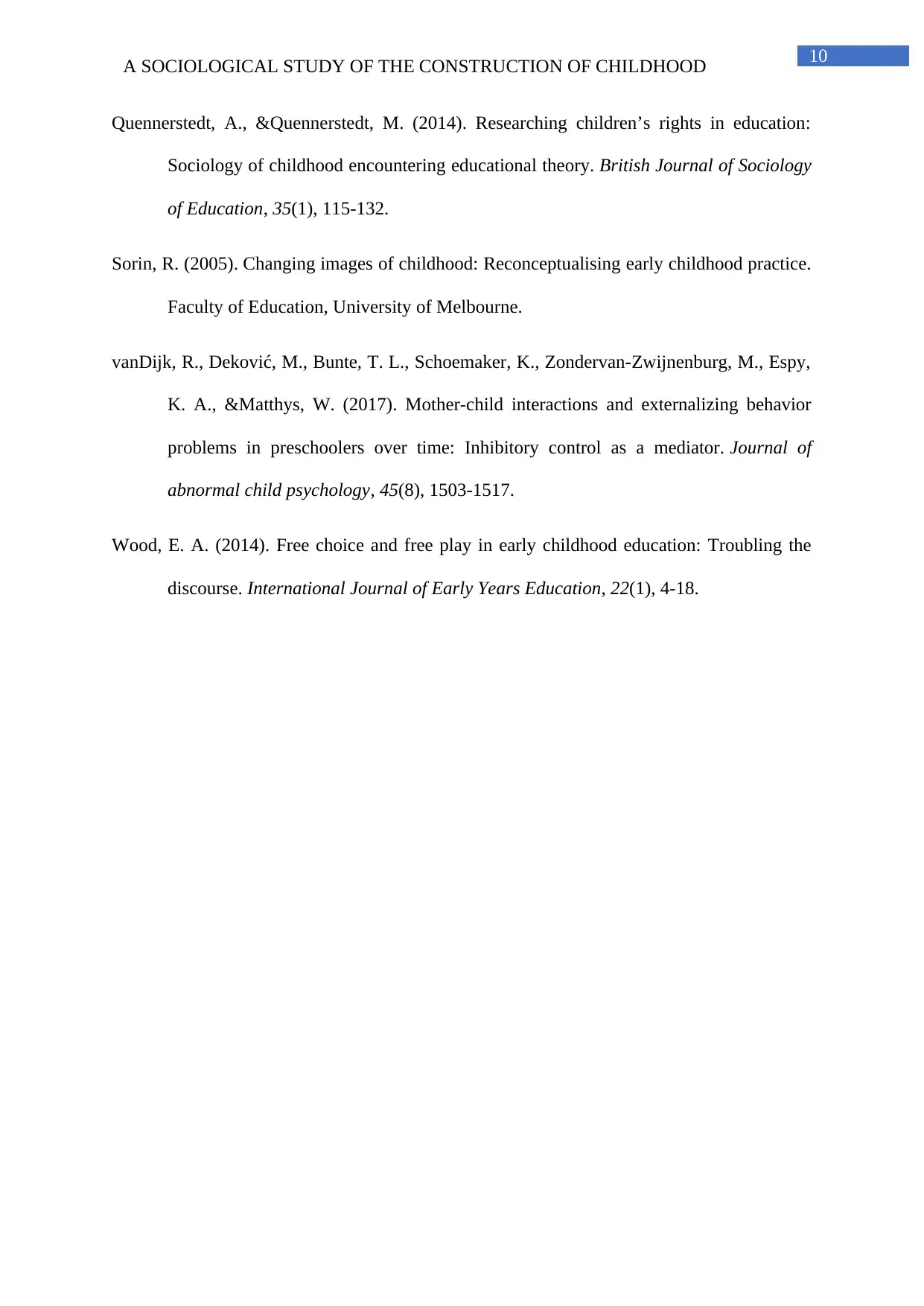
10
A SOCIOLOGICAL STUDY OF THE CONSTRUCTION OF CHILDHOOD
Quennerstedt, A., &Quennerstedt, M. (2014). Researching children’s rights in education:
Sociology of childhood encountering educational theory. British Journal of Sociology
of Education, 35(1), 115-132.
Sorin, R. (2005). Changing images of childhood: Reconceptualising early childhood practice.
Faculty of Education, University of Melbourne.
vanDijk, R., Deković, M., Bunte, T. L., Schoemaker, K., Zondervan-Zwijnenburg, M., Espy,
K. A., &Matthys, W. (2017). Mother-child interactions and externalizing behavior
problems in preschoolers over time: Inhibitory control as a mediator. Journal of
abnormal child psychology, 45(8), 1503-1517.
Wood, E. A. (2014). Free choice and free play in early childhood education: Troubling the
discourse. International Journal of Early Years Education, 22(1), 4-18.
A SOCIOLOGICAL STUDY OF THE CONSTRUCTION OF CHILDHOOD
Quennerstedt, A., &Quennerstedt, M. (2014). Researching children’s rights in education:
Sociology of childhood encountering educational theory. British Journal of Sociology
of Education, 35(1), 115-132.
Sorin, R. (2005). Changing images of childhood: Reconceptualising early childhood practice.
Faculty of Education, University of Melbourne.
vanDijk, R., Deković, M., Bunte, T. L., Schoemaker, K., Zondervan-Zwijnenburg, M., Espy,
K. A., &Matthys, W. (2017). Mother-child interactions and externalizing behavior
problems in preschoolers over time: Inhibitory control as a mediator. Journal of
abnormal child psychology, 45(8), 1503-1517.
Wood, E. A. (2014). Free choice and free play in early childhood education: Troubling the
discourse. International Journal of Early Years Education, 22(1), 4-18.
1 out of 11
Your All-in-One AI-Powered Toolkit for Academic Success.
+13062052269
info@desklib.com
Available 24*7 on WhatsApp / Email
![[object Object]](/_next/static/media/star-bottom.7253800d.svg)
Unlock your academic potential
Copyright © 2020–2025 A2Z Services. All Rights Reserved. Developed and managed by ZUCOL.
